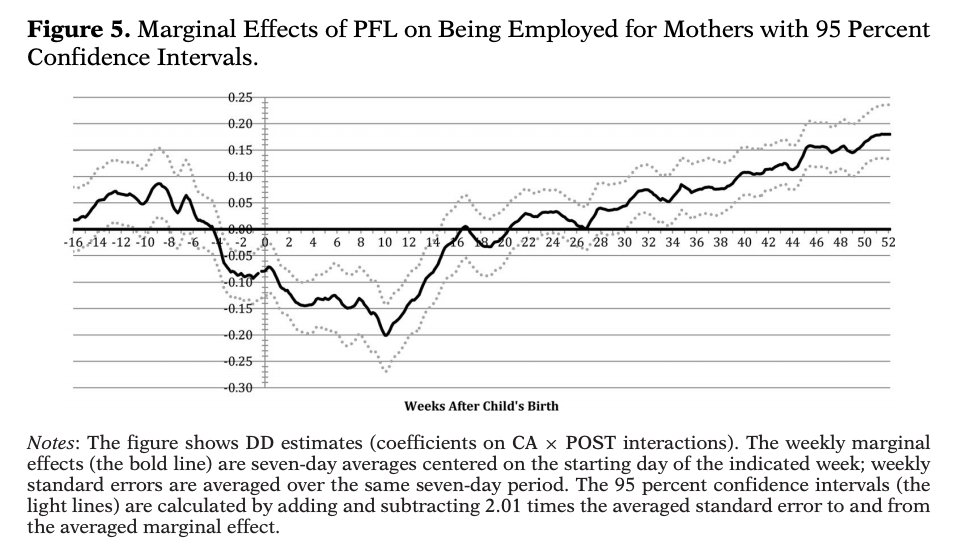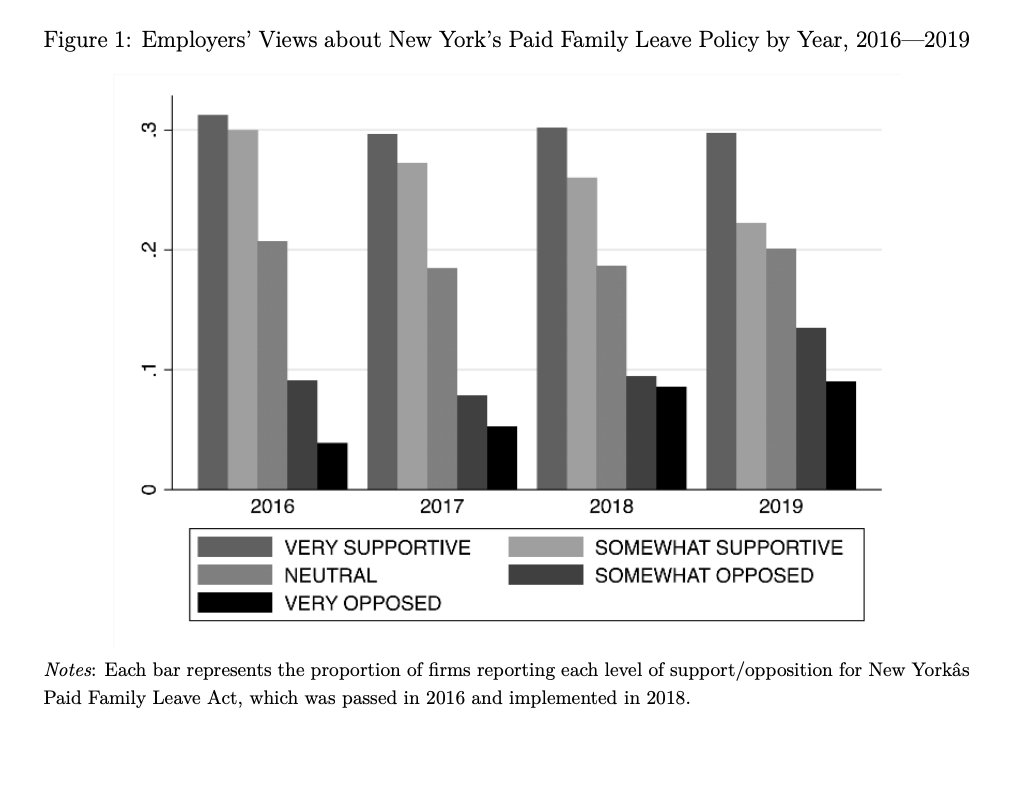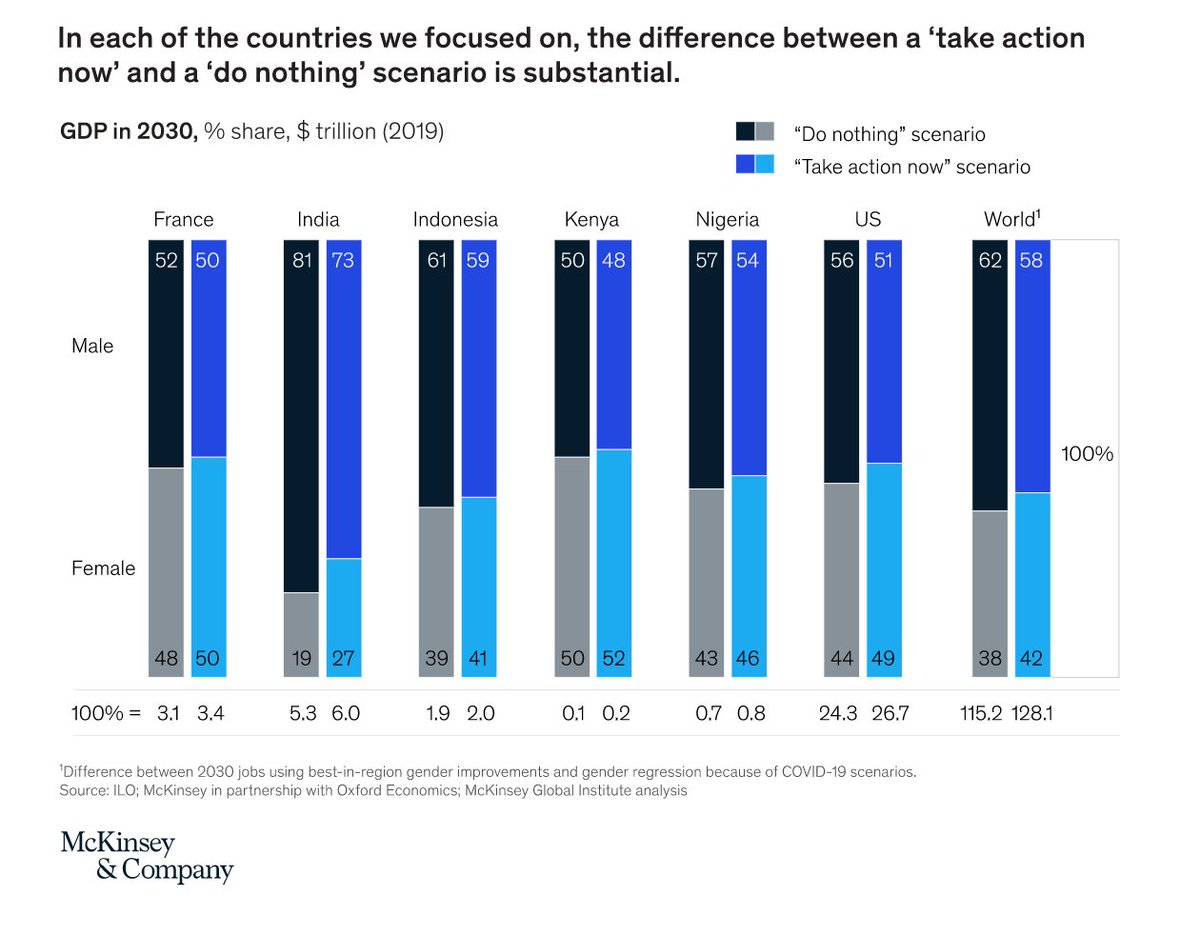With the president& #39;s joint address coming this week, some of us are busy biting our nails and wondering what his paid leave proposal will be.
Others are scratching their heads, wondering “what does paid leave have to do with economic policy anyway?”
Here are some ideas https://abs.twimg.com/emoji/v2/... draggable="false" alt="💡" title="Elektrische Glühbirne" aria-label="Emoji: Elektrische Glühbirne">.(1/18)
https://abs.twimg.com/emoji/v2/... draggable="false" alt="💡" title="Elektrische Glühbirne" aria-label="Emoji: Elektrische Glühbirne">.(1/18)
Others are scratching their heads, wondering “what does paid leave have to do with economic policy anyway?”
Here are some ideas
Labor force participation is a key engine of GDP growth, and the bulk of evidence suggests that paid leave increases LFP, especially for women.
Well-defined on- and off-ramps to work around a new child& #39;s arrival keep women doing the work that keeps the economy humming. (2/18)
Well-defined on- and off-ramps to work around a new child& #39;s arrival keep women doing the work that keeps the economy humming. (2/18)
Here’s one study that makes that point: (3/18)
https://onlinelibrary.wiley.com/doi/abs/10.1002/pam.21894">https://onlinelibrary.wiley.com/doi/abs/1...
https://onlinelibrary.wiley.com/doi/abs/10.1002/pam.21894">https://onlinelibrary.wiley.com/doi/abs/1...
But while when you hear “paid leave!” you might think “babies!” in reality, people are most likely to use paid leave for their own serious medical condition. (4/18)
Work by @urbaninstitute’s @JSmalligan and @ChantelBoyen’s suggests that paid medical leave could reduce household income volatility, facilitate reemployment, improve business productivity by reducing presenteeism, and increase labor supply. (5/18) https://equitablegrowth.org/research-paper/paid-medical-leave-research/">https://equitablegrowth.org/research-...
You can also use paid leave to care for a loved one with a serious illness, as @BrigidSchulte movingly explains. (6/18) https://www.washingtonpost.com/outlook/dying-family-time-off-work/2021/04/08/045da710-97b7-11eb-a6d0-13d207aadb78_story.html">https://www.washingtonpost.com/outlook/d...
And when California introduced paid leave for caregivers, their labor force participation increased from 66 percent to 73 percent, in comparison to a smaller increase (68 percent to 70 percent) in other states. (7/18) https://www.sciencedirect.com/science/article/pii/S2212828X2030030X">https://www.sciencedirect.com/science/a...
“Okay cool,” you say, “paid leave keeps workers working.” But what if I told you that the economic benefits of paid leave don’t stop with this generation of workers? (8/18)
Here& #39;s a list of ways paid leave boosts kids& #39; human capital:
- https://abs.twimg.com/emoji/v2/... draggable="false" alt="⬆️" title="Pfeil nach oben" aria-label="Emoji: Pfeil nach oben">breastfeeding
https://abs.twimg.com/emoji/v2/... draggable="false" alt="⬆️" title="Pfeil nach oben" aria-label="Emoji: Pfeil nach oben">breastfeeding
- https://abs.twimg.com/emoji/v2/... draggable="false" alt="⬆️" title="Pfeil nach oben" aria-label="Emoji: Pfeil nach oben">time parents talk and read to kids
https://abs.twimg.com/emoji/v2/... draggable="false" alt="⬆️" title="Pfeil nach oben" aria-label="Emoji: Pfeil nach oben">time parents talk and read to kids
- https://abs.twimg.com/emoji/v2/... draggable="false" alt="⬆️" title="Pfeil nach oben" aria-label="Emoji: Pfeil nach oben">homework help from parents
https://abs.twimg.com/emoji/v2/... draggable="false" alt="⬆️" title="Pfeil nach oben" aria-label="Emoji: Pfeil nach oben">homework help from parents
- https://abs.twimg.com/emoji/v2/... draggable="false" alt="⬇️" title="Pfeil nach unten" aria-label="Emoji: Pfeil nach unten">ADHD
https://abs.twimg.com/emoji/v2/... draggable="false" alt="⬇️" title="Pfeil nach unten" aria-label="Emoji: Pfeil nach unten">ADHD
- https://abs.twimg.com/emoji/v2/... draggable="false" alt="⬇️" title="Pfeil nach unten" aria-label="Emoji: Pfeil nach unten">obesity
https://abs.twimg.com/emoji/v2/... draggable="false" alt="⬇️" title="Pfeil nach unten" aria-label="Emoji: Pfeil nach unten">obesity
- https://abs.twimg.com/emoji/v2/... draggable="false" alt="⬇️" title="Pfeil nach unten" aria-label="Emoji: Pfeil nach unten">ear infections + hearing problems
https://abs.twimg.com/emoji/v2/... draggable="false" alt="⬇️" title="Pfeil nach unten" aria-label="Emoji: Pfeil nach unten">ear infections + hearing problems
- https://abs.twimg.com/emoji/v2/... draggable="false" alt="⬇️" title="Pfeil nach unten" aria-label="Emoji: Pfeil nach unten">head trauma (a sign of child abuse)
https://abs.twimg.com/emoji/v2/... draggable="false" alt="⬇️" title="Pfeil nach unten" aria-label="Emoji: Pfeil nach unten">head trauma (a sign of child abuse)
Wowza! (9/18)
-
-
-
-
-
-
-
Wowza! (9/18)
And paid leave is especially great when it comes to supporting small businesses, whose thin profit margins make it challenging to offer paid leave on their own. (10/18)
Research from CA, RI, and NY finds that small businesses https://abs.twimg.com/emoji/v2/... draggable="false" alt="♥️" title="Herz" aria-label="Emoji: Herz"> paid leave.
https://abs.twimg.com/emoji/v2/... draggable="false" alt="♥️" title="Herz" aria-label="Emoji: Herz"> paid leave.
And a new study of NY& #39;s state policy finds that paid leave made it EASIER for small businesses to accommodate absences, even as leave-taking increased.
No wonder small employers like the policy! (11/18)
And a new study of NY& #39;s state policy finds that paid leave made it EASIER for small businesses to accommodate absences, even as leave-taking increased.
No wonder small employers like the policy! (11/18)
Given all that, perhaps it’s not surprising that the smart people at @SPGlobal and @McKinsey estimate that in concert with other care infrastructure policies, paid leave policy could lead to big-time GDP growth.
5%!
2.4 trillion dollars!
(12/18)
5%!
2.4 trillion dollars!
(12/18)
Okay, last thing. Guess what. Paid leave isn’t just a good investment in the vibrancy of our economy, it’s a sustainable one! (13/18)
While some say that paid leave is too expensive, an @urbaninstitute analysis shows that we could enact a new self-financed paid leave program without increasing overall average taxes for ANY workers who make less than $400,000 a year!! (14/18) https://www.urban.org/urban-wire/policymakers-can-enact-paid-family-and-medical-leave-program-and-honor-biden-harris-tax-pledge">https://www.urban.org/urban-wir...
And, when it lets family members provide care, paid leave may lead to budgetary savings.
When paid leave passed in CA, the state saw an 11 percent decline in older adults& #39; nursing home use. That means big decreases in Medicare/Medicaid spending. (15/18) https://onlinelibrary.wiley.com/doi/abs/10.1002/pam.22038">https://onlinelibrary.wiley.com/doi/abs/1...
When paid leave passed in CA, the state saw an 11 percent decline in older adults& #39; nursing home use. That means big decreases in Medicare/Medicaid spending. (15/18) https://onlinelibrary.wiley.com/doi/abs/10.1002/pam.22038">https://onlinelibrary.wiley.com/doi/abs/1...
So, paid leave policy == economic policy, which is crucial to our recovery from the COVID crisis.
Now it’s time to wait and see what our policymakers propose… (16/18)
Now it’s time to wait and see what our policymakers propose… (16/18)
…if you need to do something while you wait, you can check out the full @equitablegrowth fact sheet from which these facts and figures are pulled. (citations included!) (17/18) https://equitablegrowth.org/factsheet-what-does-the-research-say-about-the-economics-of-paid-leave/">https://equitablegrowth.org/factsheet...
Or you can check out other work by some of the very smart economists and other social scientists whose research is cited in this thread:
@christopherruhm
@SamanthaTraj
@maya_rossin
@Waldfogel
@EileenAppelbaum
@MSlopen
(18/18)
@christopherruhm
@SamanthaTraj
@maya_rossin
@Waldfogel
@EileenAppelbaum
@MSlopen
(18/18)

 Read on Twitter
Read on Twitter
 paid leave. And a new study of NY& #39;s state policy finds that paid leave made it EASIER for small businesses to accommodate absences, even as leave-taking increased. No wonder small employers like the policy! (11/18)" title="Research from CA, RI, and NY finds that small businesseshttps://abs.twimg.com/emoji/v2/... draggable="false" alt="♥️" title="Herz" aria-label="Emoji: Herz"> paid leave. And a new study of NY& #39;s state policy finds that paid leave made it EASIER for small businesses to accommodate absences, even as leave-taking increased. No wonder small employers like the policy! (11/18)" class="img-responsive" style="max-width:100%;"/>
paid leave. And a new study of NY& #39;s state policy finds that paid leave made it EASIER for small businesses to accommodate absences, even as leave-taking increased. No wonder small employers like the policy! (11/18)" title="Research from CA, RI, and NY finds that small businesseshttps://abs.twimg.com/emoji/v2/... draggable="false" alt="♥️" title="Herz" aria-label="Emoji: Herz"> paid leave. And a new study of NY& #39;s state policy finds that paid leave made it EASIER for small businesses to accommodate absences, even as leave-taking increased. No wonder small employers like the policy! (11/18)" class="img-responsive" style="max-width:100%;"/>



